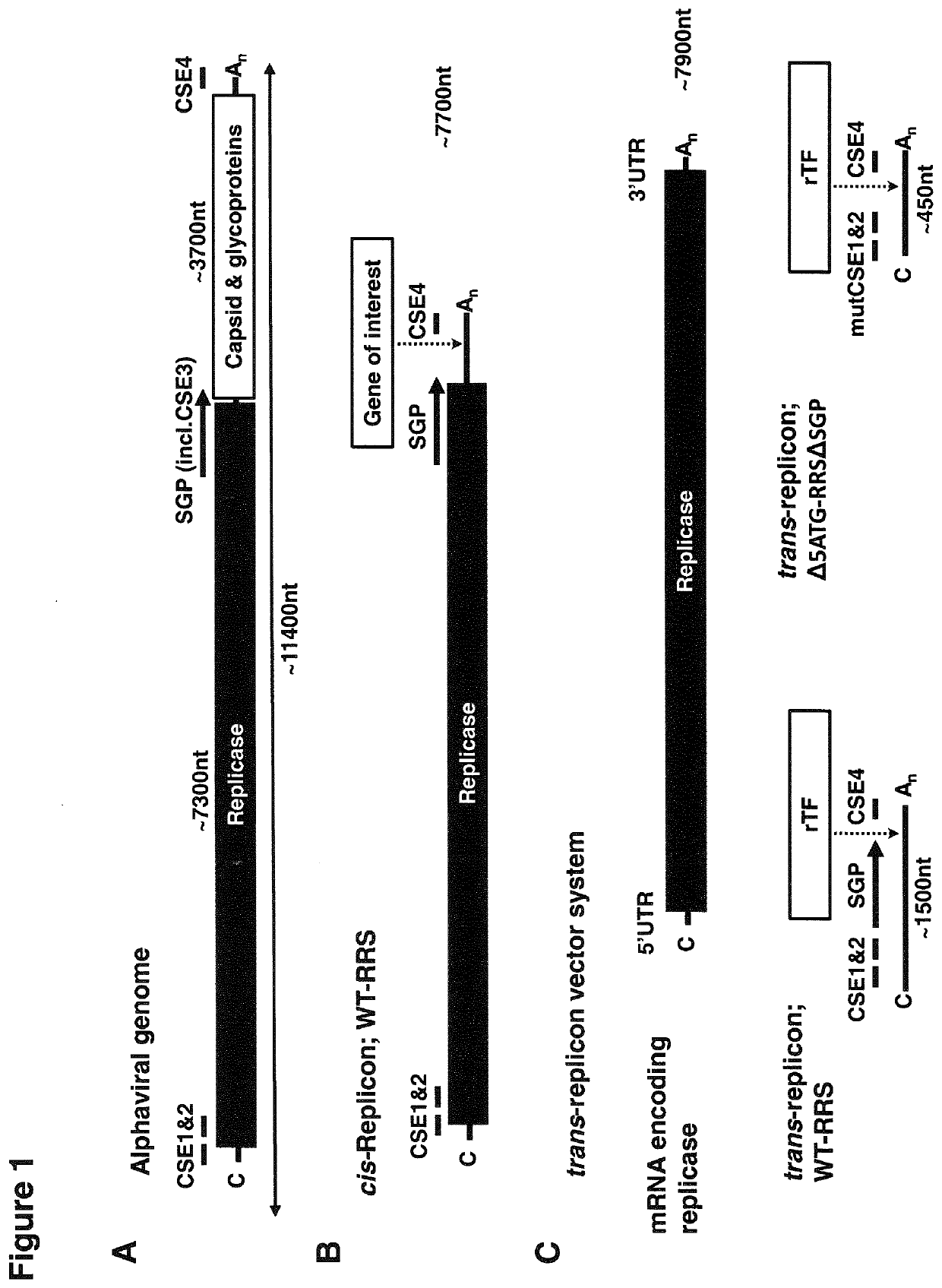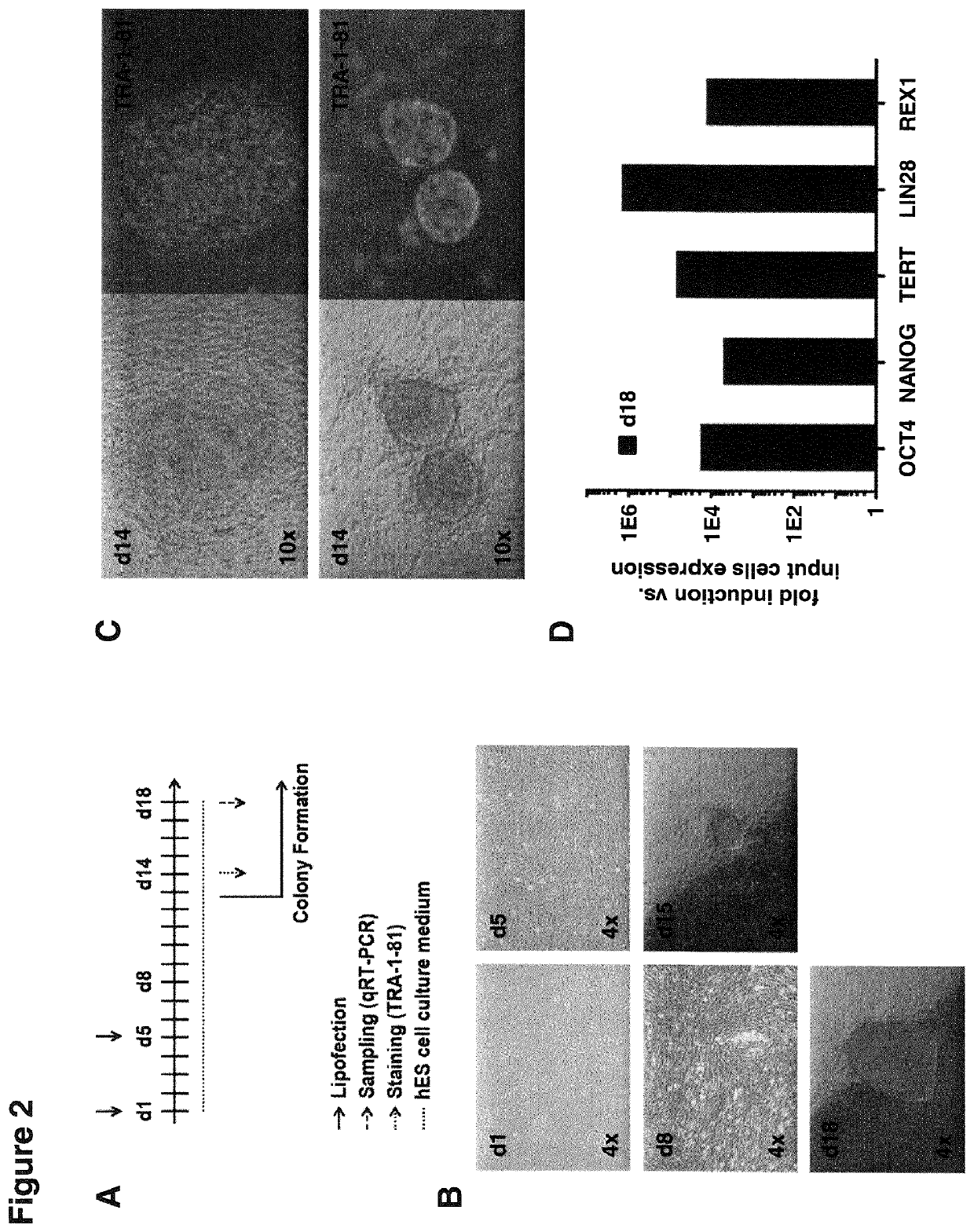RNA replicon for reprogramming somatic cells
a somatic cell and reprogramming technology, applied in the field of rna replicon, can solve the problems of limited number of types, restricted differentiation potential, poor growth, etc., and achieve the effect of convenient and inexpensive acquisition
- Summary
- Abstract
- Description
- Claims
- Application Information
AI Technical Summary
Benefits of technology
Problems solved by technology
Method used
Image
Examples
example 1
gramming Using Trans-Replicon Technology (WT-RRS)
[0627]Primary human dermal fibroblasts (HDFs, Innoprot) were plated into 6-wells (100,000 cells / well) and lipofected after 4h using per 6-well 6 μl RNAiMAX (Invitrogen) and 0.7 μg non-modified synthetic TR-WT-RRS mRNA mixture together with 0.7 μg Replicase mRNA and 0.4 μg of a miRNA mixture composed of miRNAs 302a-d and 367 (1:1:1:1:1:1). The TR-WT-RRS mRNA mixture was thereby composed of 0.4 μg synthetic mRNA encoding the reprogramming TF OSKMNL (1:1:1:1:1:1) together with 0.1 μg of each EKB. After 96h (day 5) cells were lipofected a second time using 1.7 μl RNAiMAX and 0.4 μg Replicase mRNA. Cells were cultivated in human embryonic stem (hES) cell medium (NutriStem media, Stemgent) supplemented with 10 ng / ml bFGF (Invitrogen) and 0.5 μM Thiazovivin (Stemgent) and all lipofections were performed according to the manufacturer's instructions. Colony formation was observed from d12 on and timeline of the experimental procedure is depict...
example 2
gramming Using Trans-Replicon Technology (Δ5ATG-RRSΔSGP)
[0629]FIG. 3A shows the timeline for the reprogramming of primary human dermal fibroblasts (HDFs, Innoprot). 40,000 cells were plated into a 12-well-plate and lipofected 4h thereafter using per 12-well 2.5 μl RNAiMAX (Invitrogen) and mRNA mixtures that were composed either of 0.33 μg non-modified synthetic TR-Δ5ATG-RRSΔSGP mRNA encoding the reprogramming TF OSKMNL (1:1:1:1:1:1) together with 0.02 μg synthetic mRNA of each EKB (+“EKB”) or 0.25 μg non-modified synthetic TR-A5ATG-RRSASGP mRNA encoding OSKMNL (1:1:1:1:1:1) together with 0.04 μg synthetic mRNA of N (“+N”) alone (the viral escape protein NSs (N) from Toscana virus is a potent inhibitor of IFN-response and can be used to substitute EKB for successful RNA-based reprogramming). Both mixtures were combined with 0.3 μg Replicase mRNA and 0.17 μg of a miRNA mixture composed of miRNAs 302a-d and 367 (1:1:1:1:1:1). After 72h (day 4) cells were lipofected a second time using ...
example 3
Reprogramming by One Transfection Using Trans-Replicon Technology (WT-RSS)
[0631]Primary human dermal fibroblasts (HDFs, Innoprot) were plated into 6-wells (100,000 cells / well) and lipofected after 4h using per 6-well 6 μl RNAiMAX (Invitrogen) and 0.7 μg non-modified synthetic TR-WT-RRS mRNA mixture together with 0.7 μg Replicase mRNA and 0.4 μg of a miRNA mixture composed of miRNAs 302a-d and 367 (1:1:1:1:1:1). The TR-WT-RRS mRNA mixture was thereby composed of 0.4 μg synthetic mRNA encoding the reprogramming TF OSKMNL (1:1:1:1:1:1) together with 0.1 μg of each EKB. Cells were cultivated in human embryonic stem (hES) cell medium (NutriStem media, Stemgent) supplemented with 10 ng / ml bFGF (Invitrogen) and 0.5 μM Thiazovivin (Stemgent) and all lipofections were performed according to the manufacturers instructions. Colony formation was observed from d11 on and timeline of the experimental procedure is depictured (FIG. 4A). FIG. 4B shows a microscopy analysis of colony formation from d...
PUM
 Login to View More
Login to View More Abstract
Description
Claims
Application Information
 Login to View More
Login to View More - R&D
- Intellectual Property
- Life Sciences
- Materials
- Tech Scout
- Unparalleled Data Quality
- Higher Quality Content
- 60% Fewer Hallucinations
Browse by: Latest US Patents, China's latest patents, Technical Efficacy Thesaurus, Application Domain, Technology Topic, Popular Technical Reports.
© 2025 PatSnap. All rights reserved.Legal|Privacy policy|Modern Slavery Act Transparency Statement|Sitemap|About US| Contact US: help@patsnap.com



